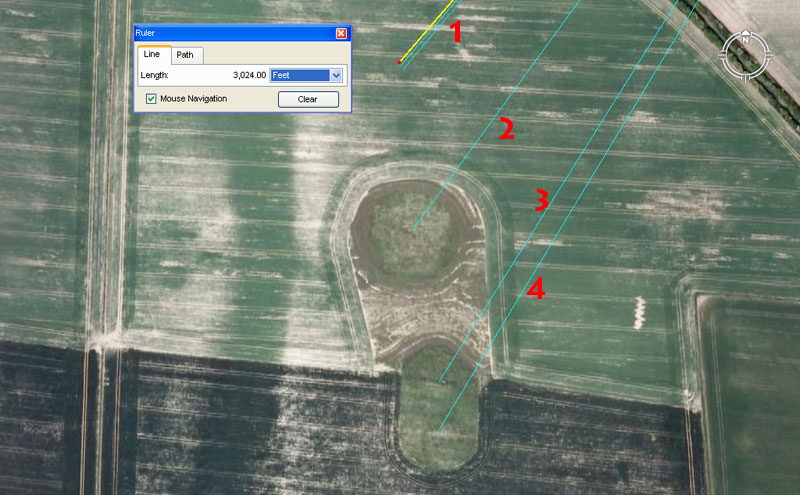
CLOSING IN ON WOODHENGE

To the NE of the main set of seven large King Barrows are these ones, including a clear crop mark of a ploughed-over and otherwise eradicated barrow. Thankfully, that one can still divulge the dynamic codes of position that were built into it during the Neolithic Age. The codes are:
1. The distance is 3024' and the angle is 40.625-degrees.
The distance is one half of 1-minute of arc, according to the Great Pyramid's literal geodetic system (based upon the combined number families "6&7"). The sum of 3024' = 756' X 4, or one circumnavigation of the Great Pyramid's base. This mound would also have carried the tutorial of 3025' for half of 1-minute of arc in a world set to 24750-miles of equatorial circumference (based upon the number "11").
The degree angles included in this mound's tutorials ranged from 40.32-degrees (408/25ths ... navigational) to 40.5-degrees (lunar) to 407/12ths to 405/8ths.Of these the most dynamic are 40.32 & 40.5-degrees, with the other two having more limited usage within the solar calendar counts.
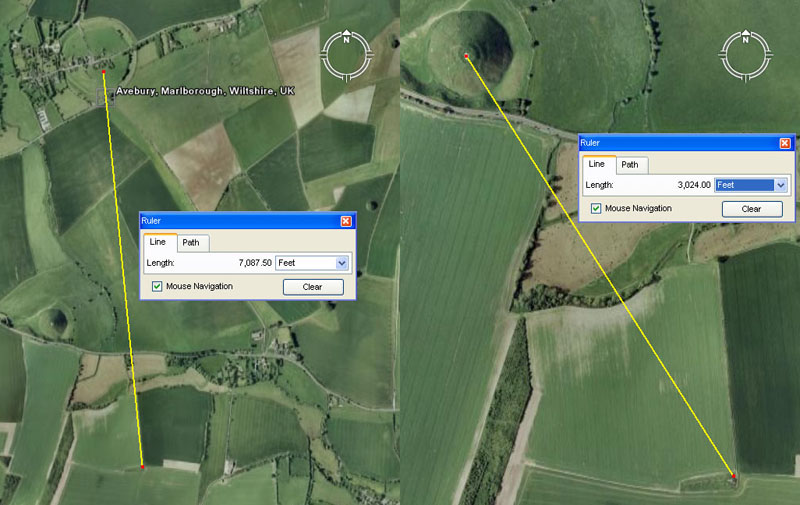
Coding found within this grouping of mounds near Durrington Walls Henge is closely similar to coding between Avebury Henge's central obelisk position, West Kennet Longbarrow and Silbury Hill's crown (as seen above). From the doorway line of standing stones at West Kennet Longbarrow to the centre crown of Silbury Hill is 3024' or half a minute of equatorial arc. Likewise, as with mound 3 in the present grouping under study, the coded or tutorial distance out from Durrington Walls Henge is 3543.75'. This is exactly half the distance from the obelisk position at Avebury Henge to the doorway obelisks at West Kennet longbarrow, where the return angle is 354.375-degrees.
1b. The distance is 3025' and the angle is 40.5-degrees.
There would be 168 occurrences of 40.5-days in the 6804-day lunar nutation cycle, 63 in the 2551.5-day lunar period monitored within the Sabbatical Calendar (7.2 lunar years) and 8.75 in a lunar year.
1c. The distance is 3024' and the angle is 40.32-degrees.
There would be 90 occurrences of 4032' in 1-degree of arc (362880').
2. The distance is 3300' and the angle is 36-degrees.
The sum of 3300' is 1/5th of an ancient English league.
The 36-degree coding also provides yet another dynamic code 180-degrees opposed (216-degrees). The sun spends 2160-years in each house of the zodiac during the cycle of Precession, etc.
3. The distance is 3543.75' and the angle is 32-degrees.
The sum of 1/32nd of a 360-degree circle is 11.25-degrees, etc. The 4, 8, 16, 32, 64 progression was very important to navigation and other ancient calculation needs. For example: 1/320th of a mile = 1 rod or perch of 16.5' or 3 fathoms.
4. The distance is 3645' and the angle is 31.104-degrees.
The distance would be 3/4ths of a Roman mile.
The 31.104-degree angle code is navigational and 3110.4-miles would be 1/8th of the 24883.2-mile equatorial circumference. The value is of such importance that it is encoded into most large sites, including within the confines of Durrington Walls Henge itself. It is also recorded within the etched lines of the Bush Barrow Lozenge artefact.
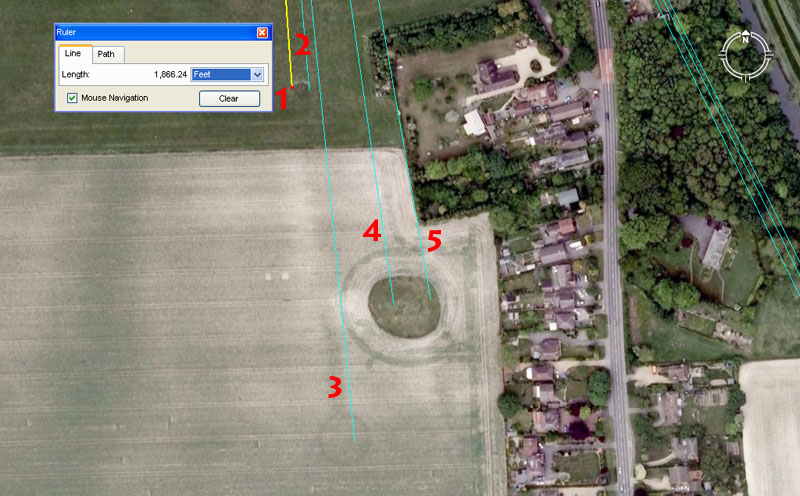
Just over 1/3rd of a mile due South of Woodhenge are these barrows, one of which is reduced to only a crop mark in the denuded field. Other lines to the right hand side of the picture resolve on positions further SSW. Here is a sampling the codes related to these mounds:
1. The distance is 1866.24' and the angle is 176-degrees.
This distance is navigational and the sum of 186624' would be 1/700th of the equatorial circumference under the 24883.2 Greek mile system.
The sum of 176' would equate to 1/30th of a mile or 1760-yards = 1-mile.
2. The distance is 1875' and the angle is 175-degrees.
The value 1875, used in a mathematical progression generates many lunar, navigation and calendar related numbers. The sum of 187.5' would equate to 1/28th of a Greek mile or 1/88th of an ancient English league.
The sum of 175' would be 1/30th of a Greek mile.
3. The distance to this faint crop mark is 2551.5' and the angle is 354.375-degrees return to Durrington Walls Henge.
Both the distance and angle are associated in a dynamic way and the tutorial offered at this mound was related to the lunar aspect of the Sabbatical calendar. The distance relates to the number of days in 7.2 lunar years or 2551.5-days. Because the lunar year was approximately 11-days shorter than the solar year, a clever mathematical method had to be created to track both the solar and lunar positions or counts, on a daily basis. It was observed that 7-solar years (2556.75-days) was very close to the count of 7.2-lunar years (2551.5-days). The difference was only 5.25-days. Therefore, the late era Druids, duplicating the practices of their distant forebears, started their solar count on the summer solstice when there was a full moon. On the sixth day thereafter (5.25-days) they had their mistletoe culling ceremony and commenced the lunar count. The two periods (7-solar years and 7.2-lunar years) thereby ended on the same day at the termination of the Sabbatical year. The ancient astronomer mathematicians could also use the half-reed rod measuring 5.25' to do both solar and lunar counts and calculations. Other than that they are known to have used parapegma boards or brass plaques like the Calendar of Coligny to very accurately track daily progress of the sun & moon within the solar & lunar cycles.
The degree angle, of course, gives the exact value for a lunar year in days.
4. The distance is 2304' and the angle is 171.875-degrees.
The distance coding is navigational and a part of a very important 1152 mathematical progression. Amongst other things the literal area of each face of the Great Pyramid was intended, by design, to be 230400 sq. ft. or 8-pyramid acres of 28800 sq. ft. each. Likewise, in a world configured to be 24883.2-miles in circumference, 1-degree of arc is 69.12-miles (23.04-miles X 3).
The angle of 171.875 carries very similar geodetic coding as the value generated by the distance, but relates to configuring the world to be 24750-miles (the "11" system of navigation). The sum of 17.1875-miles (173/16ths) would be 1/4 of the 68.75-miles that equated to 1-degree of arc under that system.
5. The distance remains 2304' and the angle is 170.1-degrees.
The lunar nutation cycle was factored, by ancient mathematicians, to endure for 6804-days or 1701-days X 4.
The foregoing analysis represents but a small sampling of the purpose built codes extractible from the landscape around Durrington Walls Henge. Yet further hundreds of mound positions have received no honorable mention in this study, regarding their planned and precisely executed positioning as surveying markers. What was happening outside the henge in "macro" across the vast landscape, where students of navigation were receiving a comprehensive education, was also happening in "micro" within the henge. We will now look at the purpose of the post circles, like woodhenge, which acted as "primers" and places of first encounter, where young initiates received rudimentary introductions to the numbers and calculation methods that they would so desperately need later as seasoned navigators aboard ships.
THE POST CIRCLES OF DURRINGTON WALLS HENGE.
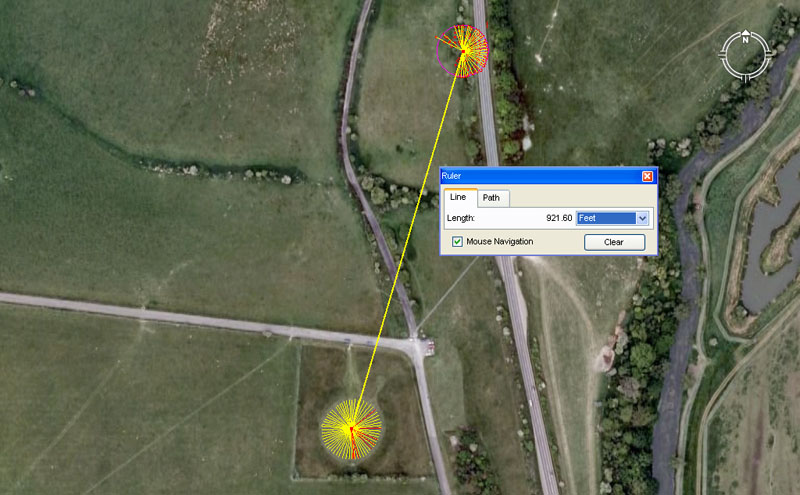
In the above picture are seen the two largest post circles associated with Durrington Walls Henge. The top one is the Southern Circle within the confines of the henge and the bottom one is Woodhenge, discovered in 1925 and subsequently restored after initial work was carried out by Maud Cunnington between 1926-29. All of the former postholes of Woodhenge were carefully excavated, with new posts (concrete) placed in the ancient holes. We, therefore, know the precise positions of the vast majority of former markers.
The Southern Circle of posts within Durrington Walls Henge was discovered in 1967 when a new road was built through the henge. All former post positions in the path of the new road were precisely surveyed, measured and photographed and a detailed plan drawn of the positions. Approximately3/4ths of the original circle has been excavated to date. Inasmuch as the unexcavated section sits well beyond the roadway, it too can be the subject of a future archaeological probe and the missing positions added to the groundplan.
The two post circles shown are separated by a distance of 9216' centre to centre at an azimuth angle of 16.5-degrees from Woodhenge's hub position. Both the distance and angle provide dynamic navigational codes. In the above picture a series of mostly yellow lines are seen to range out from the hub positions to the peripheral markers of each post circle. Each line seen provides a distance and angle code and it's very obvious that these two post-circle regions were learning centres, where initiates into the navigational and cyclic-astronomical arts were learning in micro environments the special numbers encoded into the the mound positions of the outer landscape in macro.
Lets look at these two circles in closer detail.
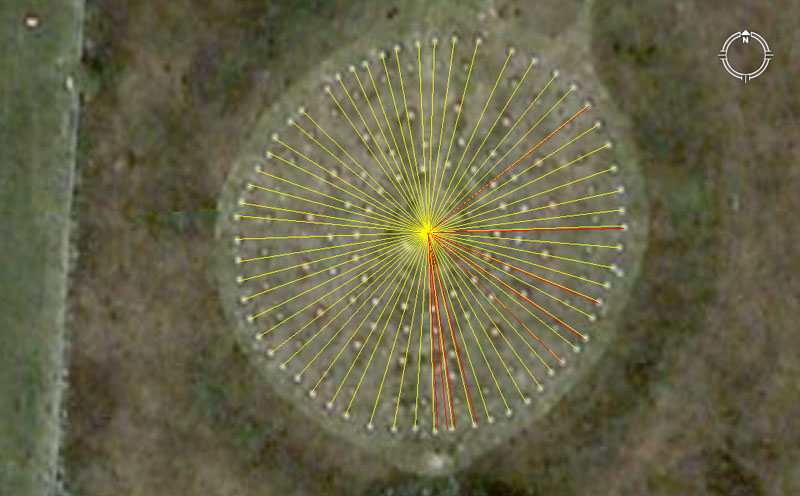
A series of lines are seen to emanate out from the centre position of Woodhenge and resolve upon outer post markers on the perimeter. The Google Earth photograph is of such quality that all of the marker posts within the site can be seen. Each vector shown is coded by both length and degree angle, making the ancient tutorials of the site still easily decipherable after thousands of years of abandonment & disuse.
In order to avoid clutter and confusion, only the outer posts are subject to analysis in the above picture, but all post positions within the concentric rings of the site can be similarly deciphered and the scientific information encoded into them extracted. Where red lines are shown, these are very important close-proximity codes which resolve in unison with other codes upon the same post.
Here are the codes of distance and angle, devoid of any explanation as to meaning. It would be a worthwhile exercise for researchers to grab a calculator, subject these values to mathematical progressions and work out for themselves the tutorials built into each position mentioned.
Beginning at the most due-north position and working around clockwise, the apparent codes are:
68.75' @ 2-deg, 70.875' @ 7.776-deg, 72' @ 14-deg, 72.9' @ 24.75-deg, 73.333' @ 31.68-deg, 74.25' @ 39.0625-deg, 75' @ 45-deg, 74.25' @ 51.5625 & 51.84-deg, 73.828125' @ 57.6-deg, 73.333' @ 64-deg, 72' @ 70.875-deg, 72' @ 77.76-deg, 70.875' @ 83.333-deg, 71.28' @ 88-deg & 268.8-deg (180-deg-opposed), 70' @ 94.5-deg, 68.75' @ 100.8-deg, 67.5' @ 106.666-deg, 67.2' @ 112-deg & 112.5-deg, 67.2' @ 117.333-deg, 69.12' @ 303.75-deg (180-deg opposed) & 124.416-deg, 68.75' @ 128-deg, 68.04' @ 314.16 & 315-deg (both 180-deg opposed), 67.5' @ 138.34-deg, 70.4' @ 144-deg, 71.28' @ 150-deg, 72' @ 155.52-deg, 72' @ 161.804-deg, 72' @ 165 & 166.666-deg, 72' @ 352-deg (180-deg opposed) & 172.8 & 354.375 (180-deg opposed), 72' @ 177.1875-deg & 178.2, 70.875' @183.75-deg, 72' @ 190.08-deg, 72.9' @ 196.875-deg, 72.9' @ 24.3-deg (180-deg opposed), 72' @ 29.53125-deg, 72' @ 216-deg, 71.28' @ 42-deg, 72' @ 42.57-deg, 72' @ 52.5-deg, 72.9' @ 58.32-deg, 72' @ 64-deg, 71.28' @ 70-deg, 70.875' @ 75.6-deg, 70' @ 81.25-deg, 70' @ 268-deg, 70.4 @ 275-deg, 69.12' @ 99-deg, 67.2' @ 105-deg, 66' @ 110-deg, 65.34' @ 116.64-deg, 66' @ 121.5-deg, 64' @ 309.2-deg (special PHI reciprocal code), 64' @ 314.16-deg, 64' @ 325-deg, 65.34 @ 330-deg, 66' @ 155.52-deg, 65.34' @ 160-deg (an opposing angle of 340.2-deg would also have provided a lunar tutorial), 66.666' @ 345.6-deg, 68.04' @ 350-deg, 68.75' @ 177.1875-deg.
Although only the perimeter codes are given here, the internal post-codes (in ever decreasing concentric rings) could just as easily be identified. The fact of the matter is that Woodhenge could be used today to teach many or most of the tutorials related to navigation and cyclic astronomy as were taught there from about five thousand years ago. In every case (and this applies equally to the outlying mounds as well) an adept tutor would know and identify the exact value encoded into each position. He would then explain in full the scientific merits of that value and the students would memorise the tutorial.
It would be argued by critics that visually measuring out such precise numbers & fractions was impossible, but that's where the tutor came in ... to identify the final refinements and their usage as mathematical progressions. The mounds and any markers placed upon them could only act as very close indicators of a code, which would be recognised because it fell so close to one of the "special" numbers.
All numbers taught (with limited exception to PHI & PI values) were highly factorable and could describe something as large as the equatorial circumference of the Earth, which, in turn, could be scaled back down to as little as 1" or even fractions thereof.
The question is, what would YOU have done 5000-years ago to teach
your students navigation and cyclic astronomy? The convenient "out"
by our so-called scholars is to say that none of this knowledge existed, despite
the fact that it's clearly encoded (by measurements, angles and proportions)
into ancient landscapes and edifices. So, the knowledge was certainly there,
but how does one record it? How does one preserve it? How does one teach it?
How does one keep it alive generation after generation?
It's recorded by setting up interrelating stone, post and mound monuments that
are linked by measurements and angles. All one then needs is standardised measurement
rules and a 360-degree angle determining device to either encode, generate or
extract the significant numbers forevermore... and generations of very adept
tutors to interpret what's happening at every position.
Barbury Castle Hill, sitting due north of the epicentre of Durrington Walls
Henge acted as the outer-marker and benchmark for all angle determinations in
the landscape surrounding the giant henge. It also acted as the surveying trig
for Avebury Henge and Silbury Hill.
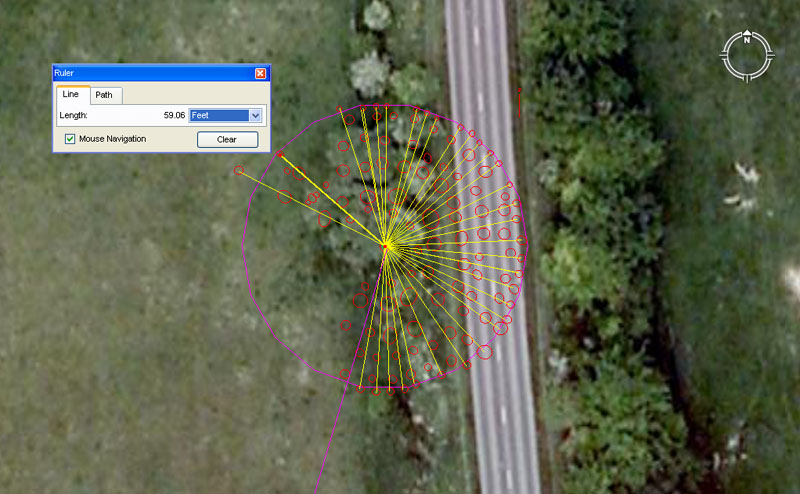
The Southern Circle of Durrington Walls Henge, superimposed accurately into the Google Earth image. The post positions, their near-shapes and sizes were created in AutoCAD architectural programme, by overdrawing a carefully scaled plan from Durrington Walls Excavations, 1966-1968, by G. J. Wainwright and L. H. Longworth, 1971.
In the above picture the Google Earth measuring tool shows that the centre section of a peripheral post sits 59.0625' from the site centre (dynamic lunar code ... 59.0625-days is two lunar months to an accuracy of under two minutes). AutoCAD measures this angle to be 311.04-degrees (dynamic navigational code). Under the 12 X 12 X 12 X 12 X 1.2-mile reading of the Earth's equatorial circumference (24883.2-miles), the sum of 3110.4-miles would equate to 1/8th part (45-degrees of arc). All of the other positions marked by AutoCAD generated vectors carry similar scientific information from the ancient parcel of special numbers. Again, all of the more inwards concentric rings of posts are similarly code-bearing and decipherable.
Here are the apparent codes, again starting at the most northern post and working clockwise:
59.4' @ .64-deg, 60' @ 13-deg, 59.0625' @ 17.5-deg, 58.32' @ 22-deg, 60' @ 32.4-deg, 60.48' (also 60.5') @ 37.8-deg, 59.0625' @ 42.52-deg, 60' @ 48-deg, 60' @ 54-deg, 59.0625' @ 63.75-deg. 59.0625' @ 72-deg, 57.6' @ 78.54-deg, 58.32 @ 87.5-deg, 58.32' @ 95.04-deg, 58.32 @ 101.25-deg (also, 101.376-deg), 57.6' @ 108-deg, 59.0625' @ 115.2-deg, 60.48' (also 60.50') @ 121.5-deg, 60.48' @ 126-deg, 61.804' (special PHI reciprocal value) @ 316.8-deg (180-deg opposed), 61.804' @ 145.8 deg, 60' @ 156.25, 60' @ 168-deg, 61.804' @ 172.8-deg, 61.804' @ 178.2-deg, 62.5' @183.333-deg, 61.804' @ 190.08-deg, ............. (big gap with many still buried and unrecorded post-hole positions) ..............., 59.0625' @ 311.04-deg, 61.804' @ 161.80339-deg (180-deg opposed angle ... both values indicating PHI), 59.0625' @ 170.1-deg & also (on the same post) 59.4' @ 171-deg, 59.4 @ 356.4-deg.
Again, this post-position "classroom" within Durrington Walls Henge had the in-built capacity to teach generations of students their rudimentary numbers and "times-tables". It would not be surprising to find out that quite young children gained a grounding related to the significance of the "special numbers" within these concentric post circles. Ancient "talent scouts" would have been on the lookout for gifted children who were mentally, psychologically and physically sturdy enough to, eventually, endure the rigours of the open sea and its storms. Here was a school where the cream of the crop could be over trained by rote and repetition for a decade or more and toughened up for a demanding career as navigators aboard the ships of "The Sea-People" (Pelasgians).
And now we'll consider the residual tutorials of the smaller northern circle:

During the 1967-68 road-building incentive yet another post circle (albeit smaller) was found within the northern sector of Durrington Walls Henge. Again, the segment that was to disappear forever under the tarmac was carefully surveyed by archaeologists and a precise map-plan layout drawn. In the above picture, the surveyed portion is shown accurately in position. As with Woodhenge and the Southern Circle of Durrington Henge, this Northern Circle shows coded vectors of distance and angle emanating from its centre to the outer post positions on the periphery. The Northern Circle sits at the apparent coded position of 425.2' (navigation) at an azimuth angle of 6.2208-degrees (navigation) from the centre of the Durrington Walls' Southern Circle.
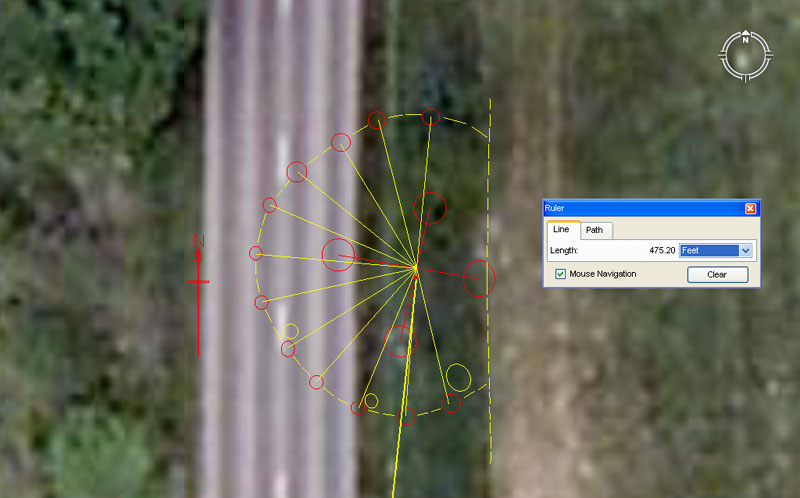
The Northern Circle accurately duplicated by an AutoCAD overdraw of the scaled plan from Durrington Walls Excavations, 1966-1968, by G. J. Wainwright and L. H. Longworth, 1971. The drawing is also placed precisely into the landscape by reference to the updated, overall plan of Durrington Walls Henge drawn by Mark Dover. Each vector seen carries very important scientific information from the parcel of special factorable numbers used by ancient English navigators and astronomers (part of the confederation of cousin nations on both sides of the English Channel known as "The Sea People").
Here are the apparent codes of this "classroom", starting at the most northern post:
24.8832" @ 5.4-deg, ....... (there is then a huge gap, where the post positions have not been excavated and recorded) ......... 22' or 22.1666' or 22.5' @ 345.6-deg (180-deg opposed), 24.3' @ 4-deg, 24.8832' @ 22.68-deg, 24.8832' @ 41.472-deg, 24.8832' @ 57.6-deg (or 237.6-deg), 26' @ 77.76-deg, 26.4' @ 275-deg (this could also equate to 95.04-deg running in the opposite direction), 26.25' @ 113.4-deg, 25.2' @ 309.02-deg (PHI reciprocal relationship), 24' @ 148.5-deg, 25.2' @ 165-deg.
The northern circle seems to be heavily biased towards the equatorial circumference of the Earth. Each time the value of 24.8832' was coded into the central region of a perimeter post sitting out from the hub, it would automatically infer 24.75' as well. There is also some very strong lunar coding in this northern post circle.
Some archaeologist have explored the theory that these post structures might have been roofed-over buildings, but have had to concede that the distribution of posts would infer otherwise. The circles would have worked well as short posts, say up to belly-button height, where length and angle measurements could be conveniently taken over their top surfaces from a central master-hub post position. These 5000-years later, the northern circle can still teach initiates scientific principles of navigation and the lunar cycles. The measurement of 25.2' recurring at a couple of positions is simply 24 Greek feet or 12 Assyrian cubits ... encoded into the English landscape long before there were any Greeks or Assyrians.
WHERE TROY ONCE STOOD
Dutch researcher, Iman Wilkins devoted 30-years to trying to locate Homer's Troy, the legendary fortress city where the greatest battle of ancient recorded history took place. The epic saga of Troy had been painstakingly memorised by generations of poet-bards and orally transmitted for about 4-hundred years until finally written down, first in Phoenician script, then archaic Ionic Greek and thus preserved in written form forevermore. This detailed account of the great battle for Troy is recorded in the Iliad of about 15700 lines of text and the Odyssey of over 12000 lines (all up about 28000 lines of text) and both works are attributed to Homer.
Homer is, however, an elusive character in history and, although recognised as the author, the Iliad and Odyssey were not written down until about 750 BC, which was something like 400-years after his time. All of the evidence would suggest that Homer was a direct witness to the 9-year battle of Troy, which occurred about 1150-1200 BC. He wrote very detailed information regarding the vast area of terrain that the war ranged over, including the many rivers (9 in the Trojan plain alone) as well as prominent surrounding landmarks, specific geographical and climatic details or fauna & flora unique to the Atlantic countries. He named the many army leaders, on both sides of the conflict and provided details of men and ships under their command. He identified the lands of origin for all of the participating army groups, as well as the topography, climate, or prominent place names within those lands on the continent. All in all it's a very detailed account, which led Greek geographer Strabo (63 BC to 24 AD) to state that Homer was the first geographer.
"first, I say that both I and my predecessors, one of whom was Hipparchus himself, are right in regarding Homer as the founder of the science of geography; for Homer has surpassed all men, both of ancient and modern times, not only in the excellence of his poetry, but also, ... about the geography both of the individual countries and of the inhabited world at large, both land and sea; for otherwise he would not have gone to the uttermost bounds of the inhabited world, encompassing the whole of it in his description"
" ... I hope, to show that Homer was the first geographer. And, as every one knows, the successors of Homer in geography were also notable men and familiar with philosophy.(See: The Geography of Strabo, Book 1, Chpt. 1).
But there's a problem and it's a very old problem that has plagued and vexed both geographers and historians for well over 2000-years. There is no location in the Mediterranean that fits what was described in such exhaustive detail by Homer. The supposed or assumed location for Troy at Hissarlik in Turkey doesn't even come close to meeting the most basic requirements. Amongst many other insurmountable problems faced by those advocating Troy being located in the reasonably placid & warm, virtually non-tidal, Mediterranean is Homer's clear statement that it was situated in "Oceanus", bordering a very tidal, wine-dark sea and lashed by the cold north wind. The term Oceanus was never used by any of the ancient Greek geographers to describe the Mediterranean, but always meant the vast Atlantic Ocean.
Moreover, Homer never stated that those
laying siege on Troy or defending its walls were "Greeks"and
any such reference in latter translations constitutes blatant mistranslation.
He said that those leading the attack were the "Achaeans"
and their many allies, all of whom can be easily identified as Celts or Proto-Celts
issuing from the Continental European countries bordering the Atlantic Ocean
and primarily the English Channel region. Alternatively, The Trojans are very
convincingly identified as Proto-Celts/ Celts living in Cambridgeshire, England,
with allies coming in from Scotland and Wales to lend support. As it turns out
the largest caches of abandoned and broken Bronze Age weapons or battle-horse
related paraphernalia ever found anywhere has been in the Cambridgeshire region,
attesting to the fact that a huge battle was once fought there that no-one remembers.
http://www.troy-in-england.co.uk/trojan-war/trojan-war.htm
THE SEA PEOPLE (The dreaded
Pelasgians) WHO SACKED MANY MEDITERRANEAN CIVILISATIONS (circa 1200 BC).
WHERE DID THEY COME FROM & WHERE DID THEY LEARN THEIR NAVIGATIONAL
SKILLS?
Iman Wilkins clearly identifies these North Atlantic seaboard countries as the home of the dreaded "Sea People", who ranged into the Mediterranean and conquered many civilisations there. He writes:
"The name 'Achaeans' means 'Watermen' or 'Sea People' (the Gothic 'acha' for 'water' or 'stream' is cognate with Latin 'aqua'). The Greek historian Herodotus (fifth century BC) confirms that Pelasgians ('Sea Peoples') had settled in Greece long before his time. They founded Athens, renamed places, merged with the local population and adopted their language".
With the Achaeans came their gods and their oral tradition, including the Iliad and the Odyssey, which were written down in Greek only around 750 BC. Meanwhile, the newcomers had engaged in the time-honoured practice of renaming towns, rivers and mountains after familiar places in their former homelands.
The transfer of place-names naturally led to the belief that the events described in the epics took place in Greece and the Mediterranean and that the Achaeans were Greeks. In this way, the origin of the Trojans and Achaeans was forgotten, while the reality behind the Iliad and the Odyssey was lost as well".
Added to that, it wasn't only place names and huge cultural influences that the Sea People brought and instituted within Greece during this period known as the Greek Dark-Ages (the period before Greece emerged into prominence as a leading civilisation), but the Sea People also brought their measurement standards and navigational sciences. It is for this reason that the Greek foot (12.6"), pace (52.5") chain equivalent (63") reed equivalent (10.5'), short stadia (525'), stadia (630'), mile (5250') and league equivalent (3.125 Greek miles), etc., are found encoded into outlying mound positions at sites all over Britain. These same measurements and others in different number families (the "11" mile of 5280' for example) are positively present in the English landscape and predate the Greek civilisation by upwards of 2500-years in some cases (Avebury Henge, Durrington Walls Henge, etc.). The basic increments of measurement used by all of the cousin Sea Peoples and their civilisations was the "British Standard Inch & Foot", which have survived until modern times and are still used in the United States. From the selfsame "inch" all of the ratio related "feet" or "cubits", etc., used and shared by the many cousin civilisations for their varied needs and calculations, were derived.
Although Wilkens can be given full credit for having done the, hard-slog, in-depth investigation and finally proving the case, he certainly does not claim to have been the first to see major problems with the concept "The City of Troy and the Trojan conflict in a Mediterranean setting". For the past 2500-years, many other notables amongst ancient Greek scholars to modern historians, archaeologists and geographers have expressed the same dissenting point of view.
But the very name "Sea People" denotes mobilised, adept mariners who ranged far and wide on trading or raiding missions and these people would have needed a very intimate knowledge of both celestial navigation and principles of precise positional plotting on the vast, featureless (and all too often treacherous) "Oceanus". Although Wilkens provides illuminating analysis that some of Homer's references to the voyages of Odyseus do, in fact, relate to zodiacal signs in the heavens and, thereby, celestial navigation, there is no information to indicate how "positional plotting" or "dead-reakoning" was accomplished. This is the only big gap in Wilkens' otherwise comprehensive thesis. He does, however, provide us with the precise position of Troy on the Gog Magog Hills of Cambridgeshire and that is all that is required to find the first "Cambridge (open air) University" of circa 1200 BC (or earlier) in the Cambridgeshire landscape.
SO, LET'S SUBJECT CAMBRIDGE TO SOME PRELIMINARY TESTS, TO SEE IF THERE ARE ANY REMNANTS OF A FORMER "OPEN-AIR UNIVERSITY" TO TEACH NAVIGATION & CYCLIC ASTRONOMY?
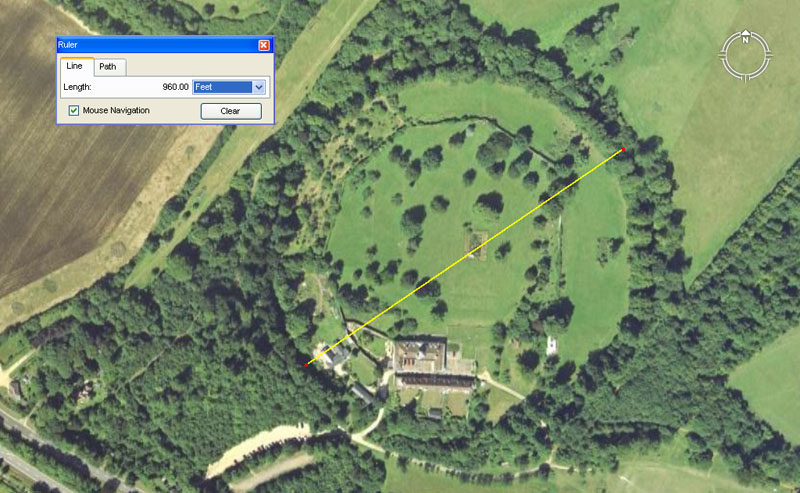
This is the large Wandelbury Ring, which sits atop the Gog Magog Hills in Cambridgeshire. The ring itself, which in this case is based upon a perfect circle, gives a reading of 960-feet in diameter across the site, ditch-base to ditch-base. The now tree lined defensive ditch or pathway circumnavigates the entire site. Although Wandlebury Ring is thought to be an Iron Age Hillfort, much has been found throughout the entire region that tells us that the location was in full use for defensive or other purposes during the Bronze Age.
This design diameter for the Wandlebury Ring relates to coding to do with the equatorial size of the Earth. At least two diameter tutorials would have been incorporated to teach principles of positional plotting at sea, where a leg of distance traveled (the diameter) needed to be turned into a circumference (the ditch path) for determining the precise degree angle back to the point of departure or onwards to the destination. Depending on the navigational method being used (6&7 or 11 families of numbers) the diameters would have been read slightly differently and a marginally different form of the PI ratio would have been used to turn a coded diameter into a coded circumference. Here are the various navigational tutorials that would have been memorised by initiates or student navigators undergoing training within the ring:
1. Under the "11" family of numbers a mile was 5280 feet or 960' X 5.5.
2. Under the "6&7" family of numbers the Earth's equatorial circumference was 12 X 12 X 12 X 12 X 1.2 Greek miles of 5250' each. By this system, which is also coded into the base dimensions of the Great Pyramid (756' per side or 3024' for 4 sides), 1-minute of arc for the world was 6048' (3024' X 2). At the Wandlebury Ring the diameter of 960' converts to a circumference of 3024' (1/2 a minute of Earth equatorial arc) using PI @ 3.125.
3. There were several ancient renditions of PI, depending on the number family one was working in. These included: 3.125, 3.1416, 3.141818182 (1728/550ths), 3.142857143 (22/7ths) or 3.15.
4. If the diameter of the site was considered to be 175 Merchant Seaman fathoms (5.5' each) then the 'cross site reading was 962.5'. Using PI @ 22/7ths , this converts to a ditch circumference of 3025', which was 1/2 of 1-minute of Earth equatorial arc under the "11" system, with a mile of 5280' (total circumference 24750 British Standard miles).
5. There are several more tutorials that would have been applied to slightly adjusted readings of Wandlebury's diameter and circumference and some of these are lunar.
It is quite certain from a surveying sense that the centre position of the Wandlebury represents the fulcrum or main benchmark position from which all of the outlying mounds in the surrounding landscape were positioned. Each of those mounds was built to be at both a coded distance and angle from the centre of Wandlebury Ring
CASTLE MOUND
There had to be some reason why William the Conqueror chose to built a Motte & Bailey castle on Castle Hill, Cambridge in 1068 and that's because it just happens to be the highest point of the city, affording the best views for defense. It's said, in fact, that if one travels directly North from that spot in a straight line, there is no higher ground between there and the North Pole.
It appears very likely that William's enditched motte-mound, built as a strong defense position, was constructed over a preexisting mound*, placed there on the highest point during the Bronze Age. The surveying and mathematical relationship between Castle Mound (what's left of King William's motte-mound) and the centre of Wandlebury Ring is just too good. Certainly, there was a castle there on Castle Mound during Roman times, with a Roman temple situated over the brow of the hill on the spot where St. Peter's Church now stands.
*Footnote: Historians are bewildered by the dubious claim that William the Conqueror could have built his many Motte & Bailey Castles in the short time claimed, given the immense quantities of packed earth required in their construction. It is far more likely that William simply built his very strategically placed sentinel positions over pre-existing hillfort mounds. Here's commentary by a researcher of William the Conqueror's Motte & Bailey castles:
'The motte and bailey castle at Dover took
just eight days to build - according to William of Poitiers who was William's
chaplain. Was such a feat possible? Building castles then was very labour intensive.
William and his men were invaders and his army would have had to be on a constant
guard especially in the immediate days after Hastings. Research on one of William's
motte and bailey castles at Hampstead Marshall shows that the motte contains
22,000 tons of soil. This motte took fifty men eighty days to build. Using this
as a guide, the motte at Dover would have needed 500 men to complete in eight
days. It is possible that local towns people were coerced into working extremely
hard to complete the task. However, building a motte was a skilled achievement.
The mottes were built layer upon layer. There would be a layer of soil that
was capped with a layer of stones that was capped with a layer of soil and so
on. The stone layers were needed to strengthen the motte and to assist drainage'.
http://www.historylearningsite.co.uk/motte_and_bailey_castles.htm
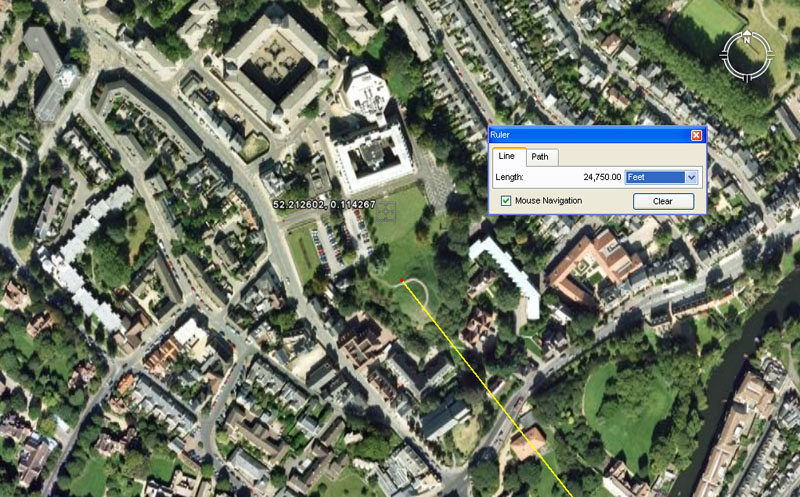
Castle Mound is situated exactly 1.5 British Standard Leagues (16500') from the centre of Wandelbury Ring (note: an ancient British league was 3.125 British miles). The azimuth angle back from the top of Castle Mound to the centre of Wandlebury Ring is 141.75-degrees. So, what are the codes carried by this outer mound position?
There are at least two length codes, actually, and one angle code:
1. The length is 24750' onto the northern end of the mound and under the "11" system of navigation and positional plotting, the Earth was considered to have a circumference of 24750 British standard miles of 5280' each. One of the ancient tutorials related to this mound was, therefore, in teaching student navigators the essential numbers related to degrees, minutes and seconds of arc under that system.
2. The distance represented 1/5280th of the equatorial circumference.
3. Concurrently to the aforementioned distance code, a position slightly further south on the crown of the mound meant 24741.9/11ths feet. Under the "6&7" system of navigation (the so-called Greek system) the Earth was considered to be (for positional plotting purposes)12 X 12 X 12 X 12 X 1.2 Greek miles of 5250' each or 24741.9/11ths British standard miles. This is the literal system built into the base dimensions of the Great Pyramid, where two circumnavigations (6048') is 1-minute of arc.
4. When standing upon the crown of Castle Mound and looking back at the centre position of Wandelbury Ring the angle around from North is 141.75-degrees. This value is part of a mathematical progression that relates in a dynamic way to the period of the Moon and there would be 2.5 occurrences of 141.75-days in a lunar year of 354.375-days.
5. The Khafre Pyramid of Egypt (Egypt's pyramid of the Moon) is 15/16ths the length of the Great Pyramid. Therefore 756' (Great Pyramid) ÷ 16 = 47.25 X 15 = 708.75' (Khafre Pyramid). Note: half of this value is 354.375' and in days that value represents the duration of a lunar year. The distance covered by two side lengths of the Khafre Pyramid = 1417.5' (708.75' X 2).
6. The coded angle of 141.75-degrees would have provided tutorials in lunisolar calendar calculations, as well as celestial navigation using the Moon as the target. It was of utmost importance to learn to calculate the period of the Moon and understand its waxing or waining cycle. Along with other things, crew aboard ships buffeted by extended storms and overcast skies over a week or two could lose track of time and the calendar date, but as long as the monthly cycle of the Moon was understood, the correct date could be calculated anew with certainty by observing the degree of lunar illumination.
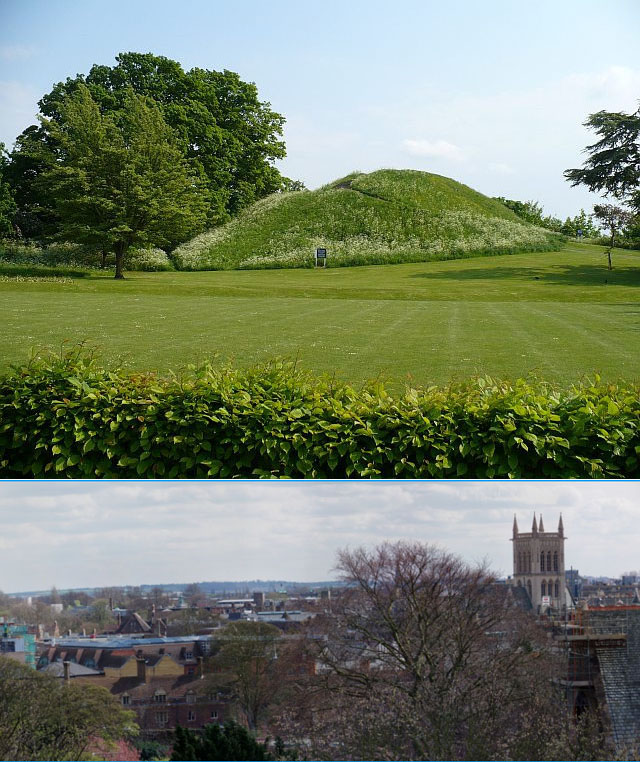
The top picture shows Castle Mound, which carries both distance and angle codes from the centre hub position of Wandelbury Ring. The bottom photo shows the skyline to the South from atop Castle Mound, including the Gog Magog Hills, partially obscured behind a tree. In ancient times both positions would have been clearly visible, one from the other, allowing for precise surveying fixes by student navigators and their tutors.
Hmmn! This is looking encouraging ... Perhaps it's time to analyse the "codes of position" of surviving mound structures anciently erected around the Gog Magog Hills? ... home of the Trojans.
Martin Doutré, September 2010 ©.